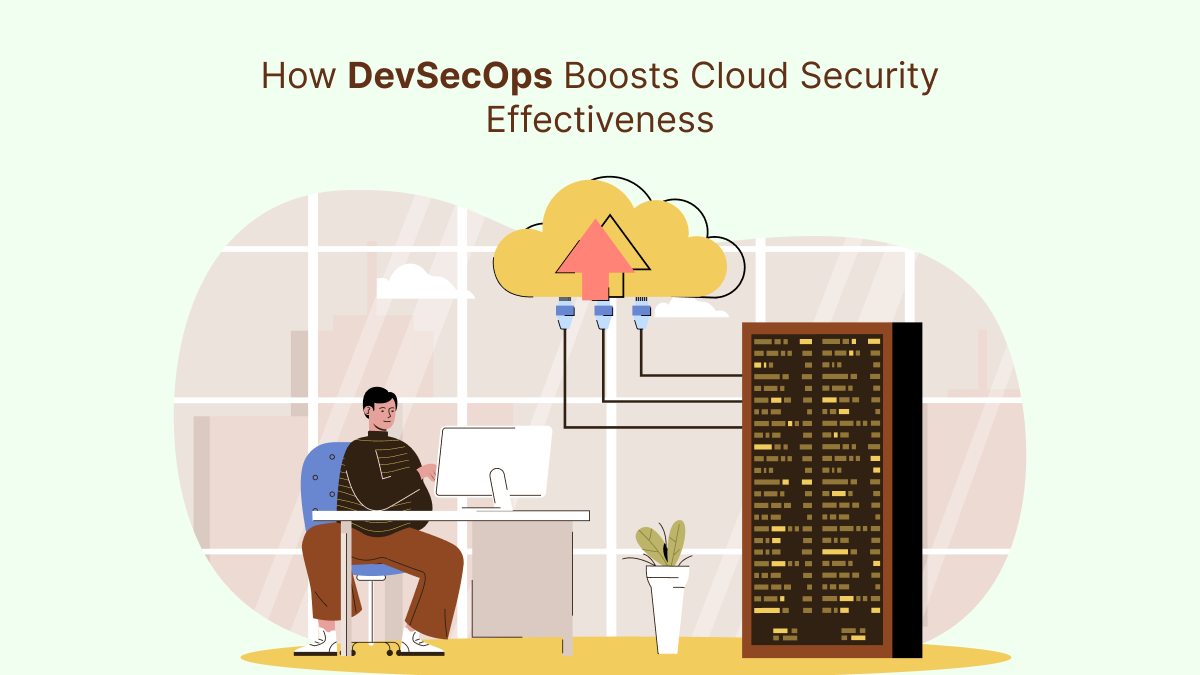In today’s digital world, where more businesses are shifting to cloud-based systems, keeping data and applications secure has become a top priority. But the old ways of doing security—where checks happen at the end—are no longer enough. This is where DevSecOps steps in.
DevSecOps stands for Development, Security, and Operations. It is not just a process; it’s a culture and a practice that ensures security is considered from the beginning of the software development lifecycle, rather than being tacked on at the end. When applied to cloud environments, DevSecOps can make a massive difference in keeping systems secure and reducing risks.
This blog explores how DevSecOps boosts cloud security effectiveness, what makes it different from traditional methods, and why more companies are embracing it.
What Is DevSecOps?
A Simple Definition
DevSecOps is about embedding security into every step of the software development and deployment process. Instead of waiting until the final stage to scan for vulnerabilities, DevSecOps makes security an ongoing part of planning, writing code, testing, and releasing applications.
This model encourages collaboration between developers, security professionals, and operations teams. Everyone works together to make sure the application is both functional and secure.
Why It Matters in Cloud Environments
The cloud brings many benefits—like flexibility, scalability, and speed—but it also introduces new challenges. Cloud environments are constantly changing, and traditional security methods can’t keep up. DevSecOps is designed for this fast-moving world, where automation, rapid updates, and continuous deployment are the norm.
It works perfectly in cloud ecosystems where microservices, containers, and APIs are used. DevSecOps helps companies protect data, prevent cyber threats, and stay compliant without slowing down innovation.
Challenges of Traditional Security Approaches in the Cloud
Delayed Detection
In traditional setups, the security team comes in at the end of the development cycle to check for issues. This approach often leads to delays, costly rework, and missed vulnerabilities—especially when updates happen frequently.
Limited Collaboration
When development, operations, and security teams work in silos, it causes communication gaps. Developers may overlook security concerns, and security teams may not understand the code. This disconnect can lead to errors, weak defenses, and slower response to incidents.
Manual and Reactive
Most traditional security practices are manual and reactive. They focus on finding and fixing problems after they happen. In a cloud environment, where things change quickly, this approach is too slow to be effective.
How DevSecOps Improves Cloud Security
Continuous Security
One of the biggest advantages of DevSecOps is that it introduces continuous security. This means that security checks happen automatically at every stage of development—from writing code to deploying apps in the cloud. This constant vigilance makes it easier to catch and fix problems early, when they are easier and cheaper to solve.
Real-Time Threat Detection
DevSecOps uses automated tools that monitor your cloud infrastructure in real time. These tools can spot unusual activity, misconfigurations, or potential threats right away. This kind of fast detection is critical in cloud environments where hackers can exploit weaknesses in minutes.
Better Collaboration and Shared Responsibility
With DevSecOps, security is everyone’s job—not just the security team’s. Developers, testers, and operations staff all play a role in building secure systems. This shared responsibility leads to better decision-making, quicker fixes, and fewer vulnerabilities.
Speed Without Sacrificing Security
In fast-paced cloud deployments, speed is important. DevSecOps helps teams move faster by automating tasks like code scanning, security testing, and compliance checks. Teams can release updates quickly while still making sure their applications are secure.
Stronger Compliance
Many industries have strict rules about how data should be stored and protected. DevSecOps helps businesses meet these rules by automating compliance checks and keeping detailed records of who did what. This makes it easier to pass audits and avoid fines.
Key Components of DevSecOps in the Cloud
Automated Security Testing
DevSecOps includes automated tools that scan for security flaws as soon as code is written. These tools check for things like weak passwords, open ports, or insecure APIs. They work behind the scenes and give developers immediate feedback so issues can be fixed right away.
Infrastructure as Code (IaC)
Cloud resources are often managed through code. With Infrastructure as Code, teams can define and control their infrastructure using scripts. DevSecOps tools scan these scripts for misconfigurations or risks, helping to prevent problems before deployment.
Continuous Integration and Continuous Deployment (CI/CD)
CI/CD pipelines allow developers to merge code changes frequently and push updates automatically. DevSecOps ensures that security checks are baked into these pipelines. Before any update goes live, it goes through tests to make sure it’s safe.
Monitoring and Logging
Effective DevSecOps in the cloud includes monitoring tools that track user behavior, system performance, and security events. Logs are stored and analyzed to detect patterns and potential threats. If something goes wrong, teams can trace it back to the source and act quickly.
Real-Life Impact of DevSecOps on Cloud Security
Let’s say a company runs a mobile app on the cloud and frequently updates it to stay competitive. Before using DevSecOps, they experienced frequent bugs and occasional security breaches because their security checks came too late.
After switching to a DevSecOps model, they integrated automated scanning tools into their development process. These tools now catch vulnerabilities as soon as code is written. Their operations team gets real-time alerts about unusual behavior, and their security team works closely with developers to ensure new features are safe.
The result? Fewer bugs, stronger security, faster updates, and happier users.
Steps to Implement DevSecOps for Cloud Security
Start With a Culture Shift
DevSecOps isn’t just about tools—it’s about mindset. Everyone involved in building cloud applications should understand the importance of security. Encourage collaboration between teams and provide training on secure coding practices.
Automate Security Tasks
Look for areas where you can automate security, such as code reviews, vulnerability scanning, and compliance checks. Use tools that integrate well with your existing development pipelines.
Integrate Security Early
Security should not be a final step—it should start from the planning phase. Include security requirements in your initial designs and continue testing throughout development.
Monitor and Improve Continuously
DevSecOps is an ongoing process. Regularly review your tools, processes, and team performance. Keep improving based on feedback and new threats.
The Future of DevSecOps in the Cloud
The role of DevSecOps in cloud security will continue to grow. As more businesses rely on cloud platforms, the need for faster, smarter, and more secure development will increase. Future DevSecOps tools may use artificial intelligence to predict risks before they occur or offer automatic solutions to common problems.
For companies that want to stay ahead, adopting DevSecOps is no longer optional—it’s essential.
Conclusion
Cloud environments offer speed, flexibility, and scale, but they also bring new security challenges. Traditional security practices can’t keep up with the pace of modern cloud development. DevSecOps solves this problem by bringing security into every step of the software lifecycle.
By using automation, encouraging collaboration, and shifting security left, DevSecOps helps teams build safer applications without slowing down. It reduces risks, helps meet compliance standards, and ensures that security is an ongoing priority—not just an afterthought.
As more businesses move to the cloud and the need for fast, secure applications grows, DevSecOps will be the key to success. Whether you are launching a new platform or working with an on demand app development company, embracing DevSecOps can help protect your users, your data, and your brand.
FAQs
What makes DevSecOps different from DevOps?
DevOps focuses on collaboration between development and operations teams to speed up software delivery. DevSecOps adds security to the mix, making it a shared responsibility throughout the development lifecycle.
How does DevSecOps improve security in cloud environments?
DevSecOps uses automation, real-time monitoring, and early detection of issues to secure cloud-based applications. It helps teams respond to threats quickly and fix problems before they reach users.
Do DevSecOps tools replace human security teams?
No, they complement them. DevSecOps tools automate repetitive tasks and provide insights, but human expertise is still needed for planning, decision-making, and handling complex threats.
Is DevSecOps only for large enterprises?
Not at all. Small and medium businesses can also benefit from DevSecOps. Many tools are budget-friendly and easy to integrate, helping smaller teams stay secure while they scale.
Can DevSecOps be used across different cloud platforms?
Yes. DevSecOps tools are designed to work across multiple cloud providers like AWS, Azure, and Google Cloud. They can also support hybrid and multi-cloud environments.



